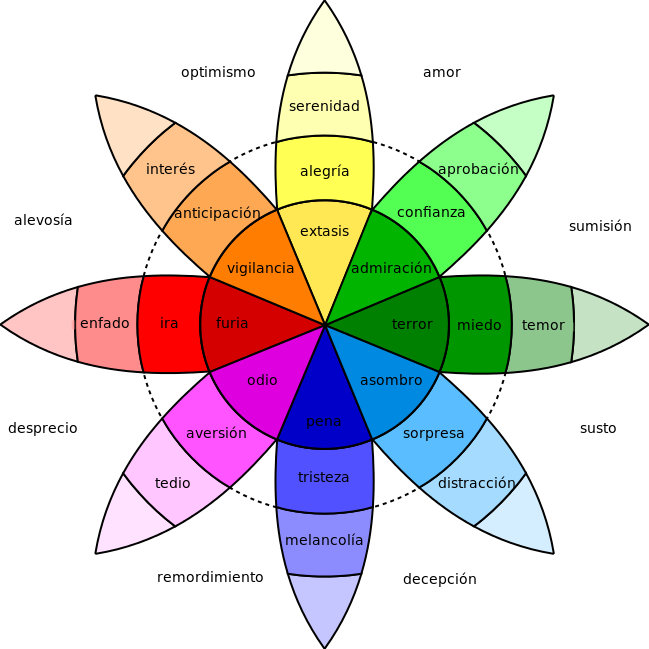The wheel of emotions

- 2253
- 586
- Charles Fay
Robert Plutchik's emotions wheel is a very useful tool that uses today those who are dedicated to coaching. But, the truth is that we can all benefit from the proposal of this American psychologist.
Emotions guide part of our day by day behaviors. They also facilitate interaction with other people.
However, these are complex. At the same time, Starting from emotions we can also elaborate feelings. That is, abstractions or interpretations that we make about an event that occurred.
Content
Toggle- What are emotions?
- How did the Robert Plutchik's emotions wheel arise?
- What is Robert Plutchik's wheel of emotions and how it is used?
- What is the wheel of Plutchik's emotions for
- Bibliography
What are emotions?
Emotions, as investigations point out, are:
"An affective state that we experience accompanied by organic (physiological and endocrine) changes of innate or influenced by experience".
For being the world of emotions and feelings so complex, the American psychologist Robert Plutchik designed a theory that would allow greater understanding about it.
According to Plutchik's theory, Human beings have evolved their emotional map in order to adapt to the environment of which they are part.
Following this idea, Plutchik classifies emotions in a primary and others that arises from the combination of primary emotions.
Primary emotions, For Plutchik, are those that make survival possible, such as Fear, surprise, disgust, anger, sadness, joy, hope and acceptance.
The rest of the emotions would arise from the combination of the former and make it possible to expand the map emotions of experiences of each.
Plutchik He also analyzed the emotions according to the degree of intensity that they present. So that fear would have less intensity than fear, for example.
It was this analysis that allowed the psychologist to affirm that:
“An emotion is not simply an exciting state, an emotion is a complex chain of connected events. The chain begins with a stimulus that includes feelings, physiological changes, impulses and behaviors ”.
Understanding this, it is worth directly analyzing what is the wheel of emotions.
How did the Robert Plutchik's emotions wheel arise?
Robert Plutchik's emotions wheel is a tool that allows us to reflect on what we feel and have a better understanding about it.
Many will ask if this wheel of emotions really is necessary, so some authors have emphasized that it is.
Just as taxonomy is necessary to achieve the definition of any science, or in the same way that a map is required to be located, human emotions also need a classification.
Previously, there was no very precise classification about emotions, but some attempts.
For example, the philosopher René Descartes distinguished six emotions, which were: love, admiration, hate, joy, desire and sadness.
Instead, another philosopher called Baruch Spinoza, believed that there were 15 passions that were basic.
These emotions were: envy, greed, jealousy, pride, humility, revenge, ambition, greed, laziness, work, passionate love, desire, paternal love, filial love, in addition to hatred.
In 1896, one of the pioneers of experimental psychology, Wilhelm Wundt, developed an affective system with three axes or dimensions, based on primary and conflicting aspects.
For Wundt the three axes They were classified as: excitation/calm, pleasure/pain and tension/relief.
Clearly, this last attempt required more content to account for the complex emotional world.
What is Robert Plutchik's wheel of emotions and how it is used?
The wheel of emotions is a tool that allows visualizing emotions in a practical way and allows us to manage them better.
Plutchik created the taxonomic system of emotions by placing eight primary emotions with others, less similar, on the opposite side.
The axes would be classified as follows, according to Plutchik:
| Happiness | Sadness |
| Dislike | Acceptance |
| Fear | Submission |
| Gonna | Dislike |
Following Plutchik's ideas, The mixture of two primary emotions would result in secondary schools.
For example:
| Acceptance | + | Fear | = | Submission |
| Gonna | + | Dislike | = | Contempt |
| Happiness | + | Acceptance | = | Love |
This wheel of Robert Plutchik's emotions has had a great impact on the world of psychology because It constitutes an approach to the formation of an architecture of emotions.
In other fields, such as Coaching, Robert Plutchik's emotions has also been used to help people become aware of their emotionality and how to make changes in their lives.
One way to use this wheel is through an exercise, scoring emotions from 0 to 10, assigning a greater score to those that identify us, so we can see how we feel in the face of the challenges of life.
What is the wheel of Plutchik's emotions for
In addition to the aforementioned reasons, Plutchik's wheel of the emotions also serves:
- Identify emotions that more dominate us at certain times and, if they are not favorable, modify them.
- Have clarity about our actions.
- Know us more, and take a step for our improvement as human beings.
Today, we can use the different tools that psychology has arranged for us in order to improve our attitudes and manage our emotions properly.
How can coaching help you
Bibliography
- Plutchik, r. (1965). What is an an emotion? Journal of Psychology: Interdisciplinary and Applied. https: // doi.org/10.1080/00223980.1965.10543417
- Plutchik, r. (1980). To General Psychoevolutionary Theory of Emotion. In THEORIES OF EMOTION. https: // doi.org/10.1016/B978-0-12-558701-3.50007-7
- Plutchik, r. (1984). Emots: a General Psychoevolutionary Theory. In APPROACHES TO EMOTION.
- Plutchik, r. (2001). The Nature of Emotions: Human Emots have deep Evolutionary Roots, A Fact that May Explain Their Complexity and provides Tools for Clinical Practice. American Scientist. https: // doi.org/10.1511/2001.4.344
- Plutchik, r. (2001). The Nature of Emots. American Scientist. https: // doi.org/10.1511/2001.4.344

